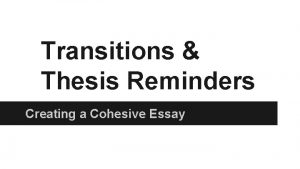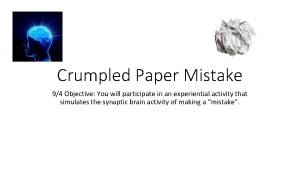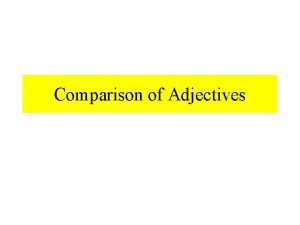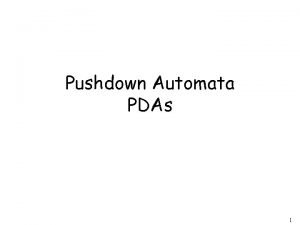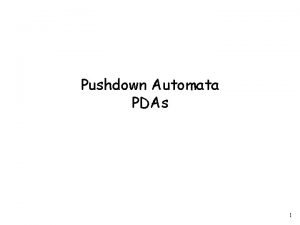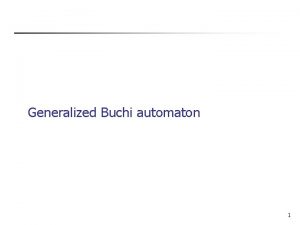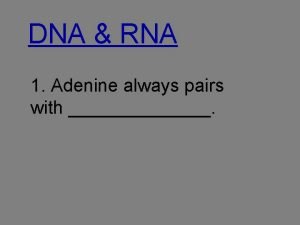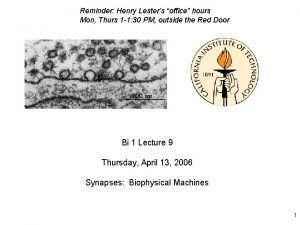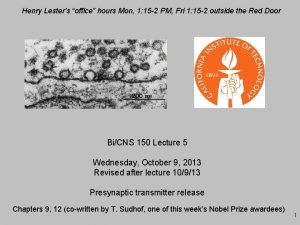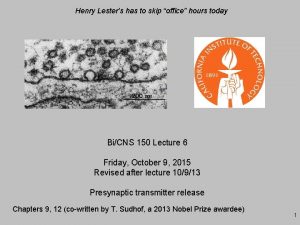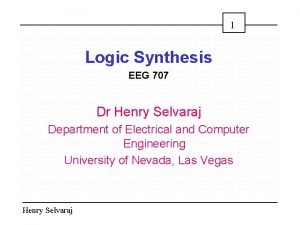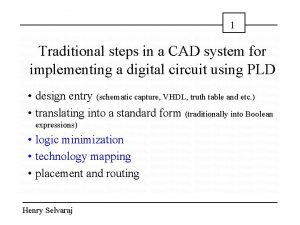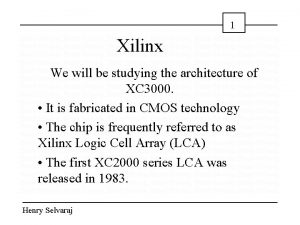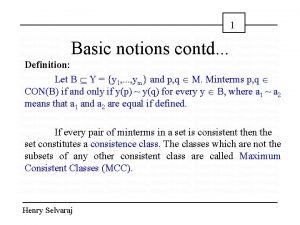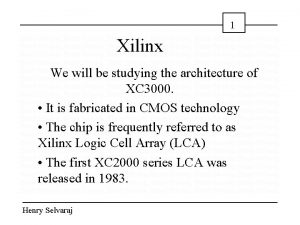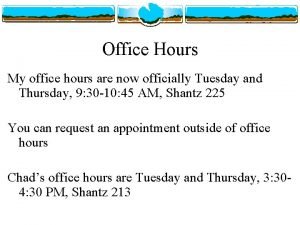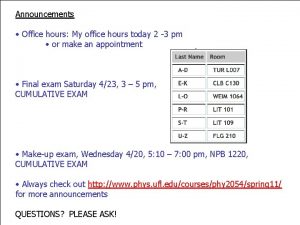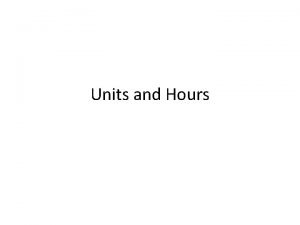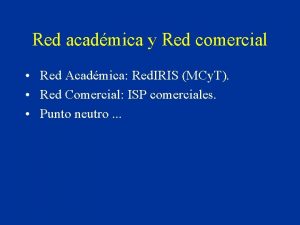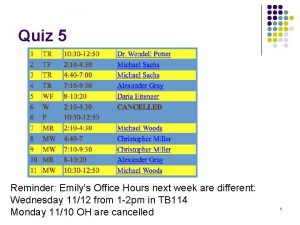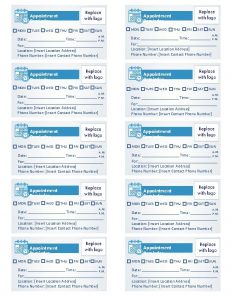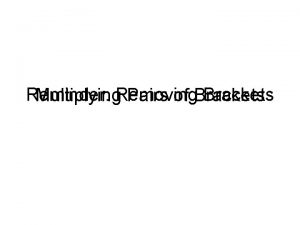Reminder Henry Lesters office hours outside the Red




































- Slides: 36

Reminder: Henry Lester’s “office” hours outside the Red Door Mon, 1: 15 -2 PM, Fri 1: 15 -2 PM Bi 150 Lecture 7 Monday, October 12, 2015 Postsynaptic acetylcholine receptors; Synaptic transmission is a δ-function in time; Channel blockers Chapters 9, 12 1

Timing of synaptic events “Synaptic delay”, between the peak of the action potential and the start of transmitter release, is ~ 0. 5 ms. Delay between the peak of the Ca 2+ current and the beginning of the EPSP is ~ 0. 2 ms (more at lower temperature). Most of the “synaptic delay” is caused in opening of Ca 2+ channels during the action potential. m. V The size and timing of the EPSP’s can be modulated by prolonging the action potential. Figure 12 -1 2

Endplate Potential is not Regenerative (contrast to Action Potential) The current source for the epp is restricted to the endplate, so the size of the potential decays with distance from the endplate (space constant ~ 1 mm). Figure 9 -5 3

electrical transmission in axons: electric field open closed Past lectures: V-gated Na+ channels V-gated K+ channels V-gated Ca 2+ channels chemical transmission at synapses: [neurotransmitter] closed open Today: ACh-gated excitatory cation (Na+ / K+ / Ca 2+) channels, Future: GABA and glycine-gated inhibitory anion (Cl- channels) Future: Glutamate-gated excitatory (Na+ / K+ / Ca 2+) channels 4

From the previous lecture Many basic principles of chemical transmission were discovered at the neuromuscular junction (nerve-muscle synapse, endplate); acetylcholine is the transmitter. Figure 9 -1 5

From previous lectures Fine structure of the nerve-muscle synapse Incl. acetylcholinesterase 0. 3 µm ACh receptors Figure 9 -1 6

The family of nicotinic ACh Receptors The mammalian genome contains 10 subunits ( 1 through 10) and 3 subunits ( 1 through 4), γ, δ, and ε subunits. Nicotinic receptors always contain at least two subunits. Muscle: (α 1)2β 1εδ Major brain ACh receptors: α 4β 2 (stoichiometry uncertain); (α 7)5 Mouse Midbrain dopaminergic cells (coronal section, tyrosine hydroxylase stain) Substantia nigra pars compacta (controls motion); lost in Parkinson’s Disease A 10 Ventral tegmental area (VTA, controls reward) Who introduced nicotine to European culture? Hint: which Holiday is today? Substantia nigra pars reticulata (GABAergic) These neurons express many types of n. ACh. R subunits and combinations 7

Nicotinic Acetylcholine Receptor (Unwin, 2005) ~ 2200 amino acids in 5 chains (“subunits”), Binding region MW ~ 2. 5 x 106 Membrane region Colored by secondary structure Colored by subunit (chain) Cytosolic region 8

The ACh. BP interfacial “aromatic box” occupied by nicotine (Sixma, 2004) Showing the cation-p interaction Y 198 C 2 W 149 B Y 93 A Y 190 C 1 non- W 55 D (Muscle Nicotinic numbering) 9

How do Nicotinic Receptors Transduce Agonist Binding into Channel Gating? Swivel? acetylcholine or nicotine Miyazawa & Unwin, Nature 2003 CLOSED Twist? Corringer et al. , J Physiol 2010 OPEN

In any case, the permeant ions experience a water-like environment CLOSED Hydrophobic Leu (Gate) OPEN Polar (Ser or Thr) –OH side chains (charge selectivity occurs in > 2 regions) 11

The Reversal Potential (Erev = EEPSP) for the synaptic potential (or current): not a True Equilibrium / Nernst Potential Membrane potential +80 ENa +60 +40 Most excitatory ligandgated channels allow flux of Na+ and K+ (sometimes Ca 2+), and Erev ~ -5 m. V. Positive to Erev, agonist pushes voltage more negative. outside GEPSP EEPSP (~ -5 m. V) GK EK (-90 m. V) cytosol = inside +20 -5 -20 -50 Resting -80 potential EK -100 At Erev , the agonist has little effect on membrane potential. Negative to Erev, agonist pushes voltage more positive. resting potential: K+ channels open Excitatory postsynaptic responses: Na+ / K+ channels open too EKGK + EEPSPGEPSP DV = GK + GEPSP

Desensitization Occurs at Many Ligand-Gated Channels Free Energy unbound voltage-clamp trace from Xenopus oocyte expressing α 4β 2 nicotinic receptors agonist Bound states with increasing affinity “closed/ resting” “activated” Highest affinity “desensitized” Reaction Coordinate 106 channels nicotine 20 sec

Time course of Postsynaptic Activation: Back to Feynman’s Idea A sensitive electronic ammeter a nicotinic acetylcholine receptor exposed to acetylcholine 5 p. A = 104 ions/ms 20 ms dynamic range: 5 ms to 5 min 1 part in 108 14

How ”tight” is the gigaohm seal? 1. Electrically tight See next slide 1 mm Alberts 11 -31 © Garland 15

How ”tight” is the gigaohm seal? 1. Electrically tight R = rl/A R ~ 109 W; r = resistivity = 22 W-cm; l = length = 10 mm; A = area = 10 mm x t (thickness); Therefore t ~ 2 x 10 -11 m, or less than 1 Å! 16

How ”tight” is the gigaohm seal? acetylcholine in the pipette opens channels in the pipette 2. Chemically tight acetylcholine outside the pipette opens channels outside the pipette The seal compartmentalizes molecules. Molecules outside the pipette do not mix with molecules inside the pipette 17

Neither Kandel nor Alberts describe Sigworth’s beautiful circuits sensitive electronic ammeter A Little Alberts 12 -22 D 18 © Garland

from Lecture 2 Max Delbruck Carver Mead Richard Feynman “If you want to measure small, noisy signals, I have a Senior who can help” H. A. L 19

Fred Sigworth ‘ 74 and Apostol’s Clock Fred Sigworth’s Web page at Yale http: //bbs. yale. edu/people/fred_sigworth. profile Ma 1 A: http: //www. amazon. com/Calculus-Vol-One-Variable. Introduction. Algebra/dp/0471000051/ref=sr_1_1? s=books&ie=UTF 8&qid =1381358906&sr=1 -1&keywords=apostol 20

channel opens Statistical analysis of single-molecule events now we synchronize artificially on the opening event n =1 0 At a synapse, the pulse of transmitter is ~ a d-function, and all postsynaptic channels open nearly synchronously Like Figure 9 -10 21

Statistical analysis of single-molecule events n =1 0 22

Molecular lifetimes from Chem 1 b Lecture Series #5 (Heath) 23

Synaptic integration 1 A. Molecular lifetimes (more in later lectures) Concentration of acetylcholine at nerve-muscle synapse (because of acetylcholinesterase, turnover time ~ 100 μs) high State 1 closed State 2 k 21 all molecules begin here at t= 0 open 0 units: s-1 Number of open channels ms 24

Lidocaine, an example of a drug that blocks voltage-gated or ligand-gated channels Alkyl substituents: may adjust charge density of amine. Affects membrane permeation. Also affects binding to the receptor. Charged amine: may bind to charged groups or π electrons on the protein Amide: hydrolyzed to terminate drug action Alky groups affect both membrane permeation and receptor binding Aromatic: may bind to nonpolar groups on the receptor protein.

Single-molecule recordings with a lidocaine analog 5 p. A Acetylcholine only 20 ms Acetylcholine + blocking drug (QX-222, analog of lidocaine) 26

Drug interactions at the nicotinic acetylcholine receptor Some drugs compete with acetylcholine Some drugs bind on the axis ~ 100 Å (10 nm) 27

Model or scheme normal function State 1 closed State 2 k 21 open units: M-1 s-1 units: s-1 simple block closed Functioning channel (1, 2) all molecules begin here at t= 0 k 21 open k 23 = k+[Drug] drug blocked Drug-blocked channel (3) 28

current time constant = 1/k 21 none time constant = 1/(k 21+ k 23) Functioning channel Drug-blocked channel 29

Stylized single-channel records for faster- and slow-binding blocking drugs Open (2) Closed (1) blocked (3) binds unbinds 30

Lidocaine blocks Na+ Channels from inside the cell inside Functioning channel “Trapped” or “Use-Dependent” Blocker lidocaine-H+ lidocaine 31

Procainamide, a use-dependent blocker stimuli Action potentials fail impulses (voltage) channel population (currents) threshold pronounced block at brief intervals little block at long intervals 32

inside Functioning channel “Trapped” or “Use-Dependent” Blocker 33

Na+ channel blockers in medicine Local anesthetics Dental surgery (lidocaine) Sunburn medications Antiarrhythmics (heart) “use-dependent blocker” example: (procainamide) Antiepileptics / anticonvulsants (brain) “use-dependent blocker” (phenytoin = Dilantin® ) 34

Superfamilies of ligand-gated ion channels that are synaptic receptors A. ACh, Serotonin 5 -HT 3, GABA, (invert. Glu. Cl, dopamine, tyrosine) receptor-channels Most ^ Figure 10 -7 35

Reminder: Henry Lester’s “office” hours outside the Red Door Mon, 1: 15 -2 PM, Fri 1: 15 -2 PM End of Lecture 7 Interested in learning more about how drugs open and block ion channels? That’s part of neuropharmacology (Bi 155, Winter 2017) 36
 Cohesive thesis statement
Cohesive thesis statement Stir you up by way of reminder
Stir you up by way of reminder Phytel appointment reminder
Phytel appointment reminder What does advertisment mean
What does advertisment mean I693 reminder letter
I693 reminder letter Growth mindset crumpled paper activity
Growth mindset crumpled paper activity Binder reminder
Binder reminder Critical reminder
Critical reminder Adjectives for reminder
Adjectives for reminder Computation symbol
Computation symbol Pda reminder 1
Pda reminder 1 Pushdown automata
Pushdown automata Pda reminder 1
Pda reminder 1 Adenine always pairs with *
Adenine always pairs with * Thanks for the reminder.
Thanks for the reminder. Sql reminder
Sql reminder Fanny girden
Fanny girden Twu financial aid office hours
Twu financial aid office hours Kent financial aid office
Kent financial aid office Csudh financial aid number
Csudh financial aid number Instructor office hours
Instructor office hours Hát kết hợp bộ gõ cơ thể
Hát kết hợp bộ gõ cơ thể Slidetodoc
Slidetodoc Bổ thể
Bổ thể Tỉ lệ cơ thể trẻ em
Tỉ lệ cơ thể trẻ em Chó sói
Chó sói Glasgow thang điểm
Glasgow thang điểm Chúa yêu trần thế alleluia
Chúa yêu trần thế alleluia Môn thể thao bắt đầu bằng từ chạy
Môn thể thao bắt đầu bằng từ chạy Thế nào là hệ số cao nhất
Thế nào là hệ số cao nhất Các châu lục và đại dương trên thế giới
Các châu lục và đại dương trên thế giới Công thức tính độ biến thiên đông lượng
Công thức tính độ biến thiên đông lượng Trời xanh đây là của chúng ta thể thơ
Trời xanh đây là của chúng ta thể thơ Mật thư anh em như thể tay chân
Mật thư anh em như thể tay chân 101012 bằng
101012 bằng độ dài liên kết
độ dài liên kết Các châu lục và đại dương trên thế giới
Các châu lục và đại dương trên thế giới
